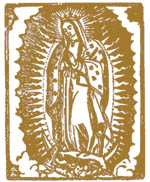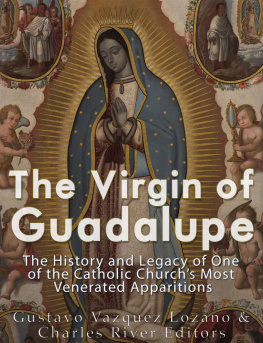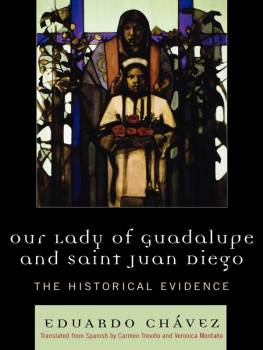The Virgin of Guadalupe
Art and Legend
Written and photographed by
John Annerino

The Virgin of Guadalupe
Art and Legend
Digital Edition 1.0
Text 2012 John Annerino
Text and photographs 2012 by John Annerino
All rights reserved. No part of this book may be reproduced by any means whatsoever without written permission from the publisher, except brief portions quoted for purpose of review.
Gibbs Smith
P.O. Box 667
Layton, Utah 84041
Orders: 1.800.835.4993
www.gibbs-smith.com
ISBN: 978-1-4236-2472-1
For my father, who first showed me the road to adventure,
For my mother, who always kept the candles burning,
For my wife, who brought a beautiful family into our lives,
And for my editor, who shepherded this book to you.
Acknowledgments
This book would not have been possible without the dedication, insight, and guidance of many kind people who helped me realize a decade-long dream of producing a book on the beloved icon of the Virgin of Guadalupe. I am grateful to editor Madge Baird, book designer Sheryl Dickert, and design assistant Melissa Dymock at Gibbs Smith; translator and confidant Alejandrina Sierra, friend Lucinda Bush Garrett, and compaero Don Julio Reza Daz for opening the secret doors along the caminos of Guanajuato; Seor Pedro Vistal Bustos and Doa Catalina Lpez, who pulled back the veil on the sacred stones of Las Carmelitas; Luis Manuel and Beatriz Delgado Sierra, who showed me the street shrines and murals of their colonial pueblo; Juan Ramn Delgado, who showed me the byways of El Bajo, La Villa, and Mexico City; Mystical Theologian and Padre David Jos Beaumont, OFM Cap., Parroquia Nuestra Seora de Guadalupe, who lives that rare humble life of giving hope, love, and compassion to the Mountain Pima in the rugged sierras and barrancas of Sonora; Anthony V. Schwan for his grace; Bill Green, La Paloma de Tubac, Arizona, for his kind permission; Oscar Hermn Sanz for his generous technical support; and muralist Miguel ngel Grijalva, artist Carlos Trujillo, and many other unknown artesanos, costureras, florists, folk artists, highway muralists, painters, sculptors, stone masons, tin smiths, and wood carvers whose work also graces the pages of this book. I am indebted to several people who opened their treasured private collections of the Virgin of Guadalupe to me: Mrs. Mary H. Garca, Menlo Park; Mrs. Ana Mara and Mr. Salvador Andrade; and Mrs. Josefina Lizarraga.
LIFE magazine director of photography Barbara Baker Burrows first opened my eyes to photographing iconic imagery by assigning me to mentor young Native American Pima students, many of whom picked up cameras for the first time to photograph their own impressions for the LIFE cover story Childrens Pictures of God.

The Virgin of Guadalupe, Highway 15 mural, Penasco Hill, Sonora, Mexico.
La Virgen de Guadalupe, mural en la Carretera 15, Cerro de Peasco, Sonora, Mxico.
Hidden Miracles
He [Juan Diego] heard singing on the little hill,
like the songs of many precious birds...
extremely soft and delightful;
He started to climb to the top of the little hill
to go see where they were calling him from.
Antonio Valeriano, 1556, from Here It Is Told, Nican Mopohua, a jewel of Nhuatl literature

Im climbing a cobblestone trail that winds around a mountain island into heavenly blue skies. Among the festive procession of people Im following are sightseers whove ridden here in taxis, cars, and stake-side cattle trucks; vaqueros whove trod here on horseback; infants whove been carried here by mothers; pilgrims whove walked here on foot; and campesinos whove hobbled here on burros. Many were called to this storied mountain to see El Cristo Rey , Christ the King. A landmark bronze statue that towers high above the mountain called El Cerro del Cubilete, it was built in honor of the Cristeros, Christian rebels, who carried a green, white, and red flag of the Virgin of Guadalupe into battle, proclaiming a faith for which many were martyred.
The trail began in the small pueblo of Aguas Buenas, Mexico, near the foot of the mountain at the shrine of El Templo de Santa Mara Reina de los Mrtires , Saint Queen Mary of the Martyrs Temple. Visitors often stopped here to pray before beginning their steep peregrination, drawn by an altar of the Virgin of Guadalupe that was adorned with red roses, archangels, and the colors of Navidad. I am among them on this beautiful winter day, captivated by the dreamy landscape that stretches beneath us as we climb higher and higher to the foot of El Cristo Rey. At 8,640 feet above sea level, El Cubilete is dwarfed by Mexicos highest mountains, a ring of supernal snow-capped volcanoes revered by the Aztecs as Citlaltpetl, Mountain of the Star, Popocatpetl, Smoking Mountain, and Iztacchuatl, Sleeping Lady. The geographical center of Mexico, El Cubilete offers a commanding view of El Bajio, The Lowlands, of the Cordillera de Anhuac, a fertile volcanic plateau that arcs midway across the republic from the Gulf of Mexico to the Pacific Ocean.

The Virgin of Guadalupe, altar, Saint Queen Mary of the Martyrs Temple, Aguas Buenas, Guanajuato, Mexico.
La Virgen de Guadalupe, altar, El Templo de Santa Mara Reina de los Mrtires, Aguas Buenas, Guanajuato, Mxico.
From my aerie, I stare north across the oak- and pine-covered mountains of the Sierra de Guanajuato and retrace the historic silver roads far beyond the horizon. A week earlier I had departed from El Paso, Texas. Thats where my family and I often began our travels down El Camino Real de Tierra Adentro to celebrate Navidad in Guanajuato. Where Spanish colonists once endured an arduous three-month journey on burro-drawn wooden carts and ox-powered wagons, we traveled by train, truck, or bus, following the southern leg of the 1,600-mile-long Royal Road of the Interior Lands from Ciudad Jurez to Chihuahua, Durango, Zacatecas, Aguas Calientes, Lagos de Moreno, and Guanajuato. In the heyday of the Royal Road, which linked the Royal Mint in Mexico City with the capitol of Santa Fe, New Mexico, these pre-colonial and colonial cities bustled with haciendas, missions, mercados , presidios , and the richest silver mines in the world.
Perched on a breezy overlook on the rim of El Cubilete, I traced the myriad roads that branched off the southern reaches of the Camino Real that created their own histories, legends, and songs. Some were made famous in Jos Alfredo Jimnezs heart-wrenching ballad to his home and paisanos , Camino de Guanajuato : The road to Santa Rosa, the Sierra of Guanajuato, there just behind the hills, you can see Dolores Hidalgo. There Ill stay, my countrymen. My beloved town is there.
Over the years, Ive had the good fortune to follow those caminos in many directions. I stood in the church plaza of Dolores Hidalgo and recalled the impassioned voice of revolutionary priest Miguel Hidalgo y Costilla invoking










